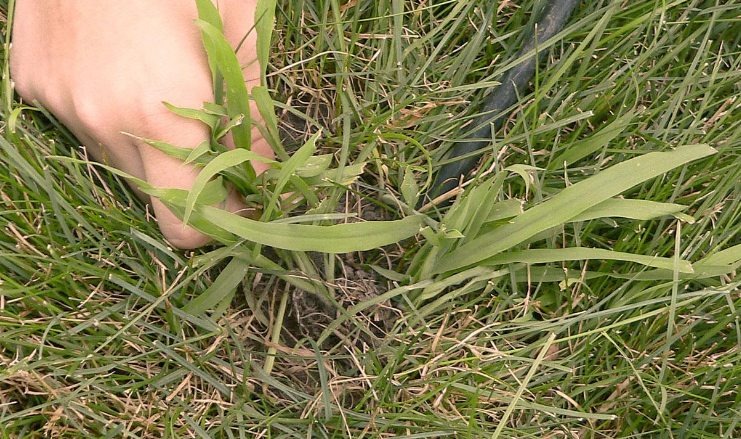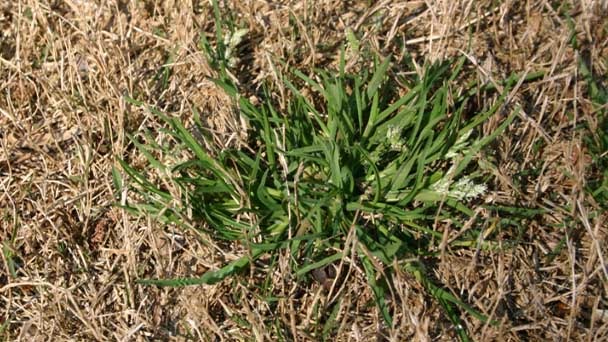Common lawn weed crabgrass typically starts to grow in late May in the North and as early as February in the South. The earliest part of spring, when the soil temperature reaches about 55 °F, is the ideal time to apply crabgrass pre-emergent.
When to Apply Crabgrass Preventer Down
To effectively control this weed, timing is everything. The best time will change depending on your location and the temperature of the soil. The temperature of the soil is influenced by how much sun and shade your lawn receives. Here are general guidelines:
- Northern states: Apply at the beginning of May
- Southern states: Apply potentially as early as February into early March
Many gardeners adhere to the tradition of spraying crabgrass killer in the early spring right after the forsythia bushes have finished blooming. However, a lot of lawn care businesses favor to use crabgrass killer right when the forsythia bushes start to bloom. Use a soil thermometer to take a reading a few inches into the lawn to get a more precise idea of when to apply crabgrass killer.
To ensure you don't miss the ideal time for application, start taking readings with a soil thermometer as early as February, depending on where you live. The majority of crabgrass seeds start to germinate when the soil temperature reaches 55 to 60 degrees Fahrenheit for a few days in a row, so that's when you can apply a crabgrass preventer. Get information on the soil temperatures in your area by entering your precise location into a soil temperature map.
What is Crabgrass?
An annual weed, crabgrass grows in clumps. The word "grass" is included in the name because, while it is a grass, you wouldn't want it to grow in your yard.
Crabgrass is not a lovely, lush turf grass. It is merely distasteful. The drought and heat don't bother crabgrass at all. It spreads out very quickly once it begins to grow.
Crabgrass will die off in the winter and won't grow back because it is an annual weed. Because it had been scattering seeds on your lawn since the previous spring when it was alive, you will see it again in the spring.
Up to 10,000 seeds can be produced by a single crabgrass plant. Those seeds will quickly disperse, sprout, and cover your entire lawn. The springtime germination of crabgrass is followed by late summer germination.
Here at Evergreen our lawn care specialists would be happy to help you get your lawn ready for spring.
Types of Crabgrass Preventers
The seeds left over from the previous growing season are prevented from sprouting by pre-emergent herbicides, also known as crabgrass preventers. Here are types of pre-emergent crabgrass preventers:
-
- Liquid: A large lawn can be effectively covered with a liquid preventer. Using it to kill seeds in sidewalk, driveway, and patio tight cracks is also successful. It may be necessary to mix and use a sprayer with a concentrated liquid solution.
- Granular: Granular formulations work well for small lawns when spread with a spreader and then watered in. Granular forms do, however, require more time to operate than liquid ones.
Chemical herbicides are used to eradicate crabgrass using synthetic herbicides.
- Organic Herbicide: There are organic techniques that will kill crabgrass, such as vinegar or corn gluten, if you are concerned about any side effects of using chemicals. These require application at precisely the right moment and temperature and function much more slowly. Using vinegar to kill crabgrass can also kill the grass you're trying to cultivate
- Selective Herbicide: Typically, this product contains chemical ingredients that only harm the weeds you choose to eradicate while being completely harmless to other plants and grasses. If you only want to kill crabgrass, use products with ingredients like dithiopyr, benefin, and oxadiazon1.
- Non-selective Herbicide: Normally, this chemical kills all kinds of weeds, but it can also harm grasses. If you want to kill something other than crabgrass, use this product.

When to Use Crabgrass Preventer
With the warming of the soil, crabgrass seeds begin to sprout. Initial emergence typically happens when the ground reaches a temperature of about 55°F, and the majority of seeds germinate between 60°F and 70°F. The primary factors affecting soil temperatures in your lawn are sunlight, wind, moisture, and how much shade it receives. In the Midwest, the soil reaches these temperatures in the spring as warmer temperatures start to prevail. Given everything, 55°F soil temperature is the ideal level for applying weed treatments. By entering your city or zip code into the GreenCast soil temperature tool, you can keep track of the soil temperature in your neighborhood. For a crabgrass preventer to be effective, timing is essential when applying it to your lawn. If used too soon, it might disintegrate before the seeds sprout. If used too late, an infestation could already be in full swing. Pay close attention to the soil's temperature, and if you can, try to apply a crabgrass preventer just before it is predicted to rain. The treatment will be washed off the grass blades and into the soil, where it will fertilize the crabgrass seed.
How to Apply Crabgrass Preventer
The herbicide crabgrass preventer is pre-emergent as opposed to post-emergent. Before the crabgrass seeds germinate, it must be used. Applying in the early spring puts you a few steps ahead of the competition. You can be sure you're getting the best crabgrass preventer available by using Estate Crabgrass Preventer, according to the lawn and garden experts at Blain's Farm & Fleet. Use a lawn spreader or garden seeder to apply the preventer. Apply it evenly across your lawn, being careful not to miss any areas. To ensure that the crabgrass preventer/fertilizer is effective after application, you must regularly water your lawn. Wait until your lawn has been mowed a few times if it was just seeded before applying. If not, the grass seedlings risk being killed. Keep in mind that when applying an herbicide to your lawn, you must always adhere to the manufacturer's instructions. Do not become alarmed if the crabgrass preventer is not applied in time. To solve this issue, Blain's Farm & Fleet sells several crabgrass spray killers. In addition to using herbicides, there are other methods for controlling weeds in the lawn. To prevent lawn weeds, you can pull weeds by hand, add mulch to your backyard, and regularly mow your lawn. Read through our, "Lawn Problems: Lawn Weeds" article for more tips and tricks. We at Blain's Farm & Fleet are aware that you take great pride in your lawn. We carry all of the lawn care equipment you require to keep your lawn looking lush and green because of this. With a wide selection of grass seed and fertilizers, Estate can teach you how to maintain your lawn all year long. Your yard is covered when it comes to us.
Crabgrass Lifecycle
As soon as soil temperatures reach 55 degrees Fahrenheit for a few days in a row in the early spring, crabgrass seeds begin to sprout. The germination window, when soil temperatures are at their best, can, as we already mentioned, extend from early spring into the first few weeks of summer.
The sun and the hot summer months are better for the crabgrass' growth than complete shade. Crabgrass is a grassy weed that prefers open spaces, so any bare patches in your lawn will soon be colonized by it.
Without control, crabgrass spreads rapidly each year and releases thousands of seeds. It can take over your entire lawn in a short period of time, outgrow your healthy grass, suffocate it by depriving it of sunlight, water, and nutrients.
The crabgrass dies off at the end of the growing season, but the seeds stay in the soil over the winter and will germinate and grow again the following spring and summer.
Because of this, it is crucial to use a crabgrass pre-emergent before the seeds sprout. Crabgrass should ideally be avoided before it fully develops.
Crabgrass Identification
Crabgrass is an annual grass weed, including large and smooth varieties. These are distinct from broadleaf weeds, biennial weeds, and perennial weeds. Crabgrass will change color from a lighter green to a darker green as it matures. Purple can also appear on some crabgrass species.
The crabgrass grass blades can have white fuzz and a pointed spade tip. It will start to set seed as it gets older. Four seed heads will group together as the seed heads enlarge. – like a fan.
For example, clumping tall fescue, creeping bentgrass, poa trivialis, etc. can all be mistaken for crabgrass if your lawn is patchy.
Final Thoughts
One thing to keep in mind is that the best course of action for crabgrass is weed prevention. Before any crabgrass appears to be growing, you should start treating for it.
The second thing to keep in mind is to make sure the second dose is applied. Three months after the first dose, the second dose must be administered. Positive outcomes won't come from completing one application without completing the other.
When you spot a patch of crabgrass, get rid of it right away. Make sure to get rid of the plant and its roots. To aid in pulling out the roots, use a garden weeder tool.
Crabgrass is unable to infiltrate your lawn when there is robust, dense grass. Crabgrass will infiltrate and begin to spread when there are areas of your lawn that are dry or bare.
Crabgrass Preventer FAQs
Can You Apply Crabgrass Preventer in Summer
Yes. The best way to treat crabgrass in the summer, early, is by applying a second application of pre-emergent herbicide, Dimension (Dithyopyr). By doing this, new crabgrass plants won't grow from crabgrass seeds. Kill crabgrass in the summer with an herbicide containing Quinclorac for post-emergent control.
Can I Apply Crabgrass Preventer in the Fall
Late August to early October is when the first application for the fall season must be submitted. To ensure complete control until the lawn awakens from dormancy in the following spring, a second application should be made to your lawn 6–10 weeks after the first fall application.
Should I Water After Applying a Crabgrass Preventer?
Yes, in order for prodiamine and dithiopyr to activate and form the vapor barrier, they must both be watered in and moved into the soil.
Should I Mow before Applying Crabgrass Preventer
For newly seeded lawns, wait until you've mowed your lawn three times before applying the herbicide to avoid killing the new grass seedlings. Throughout your lawn, evenly apply the herbicide. If you miss a spot, crabgrass may establish itself and then spread to other areas of your lawn.
Can I Apply Crabgrass Preventer Twice?
Yes, it is best to apply crabgrass preventer in two separate applications. For season-long coverage, apply crabgrass pre emergent (prodiamine) in the early spring and another round (dithiopyr) in the early summer.
Can You Apply Too Much Crabgrass Preventer?
Yes, these Group 3 herbicides have maximum annual rates. Root pruning and root growth inhibition are characteristics of crabgrass preventers, and excessive application can harm the roots or your healthy grass.
Can You Apply Scott's Crabgrass Preventer on Wet Grass?
It works best on dry grass blades. However, if the turf is wet or damp, make sure to water the product in right away after spreading.
Should I Apply Crabgrass Preventer before Or After Rain?
Crabgrass preventer can be used prior to rain to ensure that it is activated and watered into the soil. It's possible for the herbicide to be washed away by excessive or torrential rain, though.

